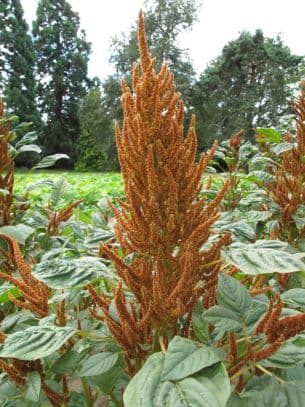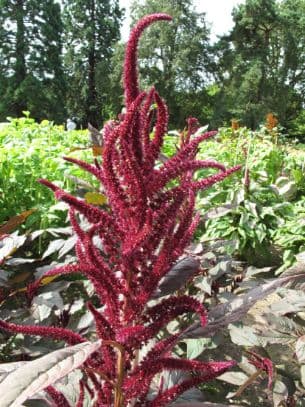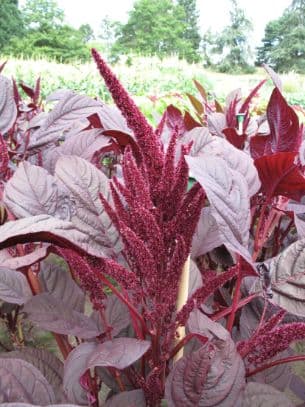Love-lies-bleeding Amaranthus caudatus

ABOUT
Amaranthus caudatus, commonly known as love-lies-bleeding, is a strikingly distinctive plant with a dramatic appearance. It is recognizable for its long, pendulous, tassel-like flower spikes that droop downwards, reminiscent of flowing tresses. These blooms can vary in color, with the most common being a deep crimson red, though they also appear in shades of green or gold. The leaves of love-lies-bleeding are broad and somewhat lance-shaped, usually displaying a deep green color with a slightly lighter underside. In some varieties, the foliage may have a tinge of red or purple, especially around the veins, which can add to the plant's ornamental appeal. Adding to the ornamental value are its seed heads, which are quite dense, adding to the textured look of the plant. Though it's primarily grown for these showy flowers, the seeds are also noteworthy. They are tiny grains that, in the past, have been harvested as a pseudo-grain for their edible and nutritional qualities, similar in use to more widely known grains. Its overall form is upright, with stems that can branch out, giving it a full and bushy appearance. The stems themselves are often reddish or greenish and may have a somewhat zigzag pattern. The plant's foliage and flower spikes will create a lush, exotic look wherever it is planted, giving gardens a unique vertical interest due to its drooping blooms.
About this plant
 Names
NamesFamily
Amaranthaceae.
Synonyms
Love-Lies-Bleeding, Velvet Flower, Tassel Flower, Foxtail Amaranth, Quilete, Pendulum Amaranth, Prince's Feather, Inca Wheat.
Common names
Amaranthus abyssinicus, Amaranthus edulis, Amaranthus leucospermus.
 Toxicity
ToxicityTo humans
Love-lies-bleeding is generally considered non-toxic to humans. However, the leaves contain oxalates, which can be harmful if consumed in large quantities. Eating significant amounts of oxalates can lead to the formation of kidney stones. The symptoms of oxalate poisoning include irritation of the mouth, throat, and gastrointestinal tract, difficulty swallowing, drooling, and stomach pain. Prolonged ingestion of high quantities can result in kidney damage.
To pets
Love-lies-bleeding is not typically toxic to pets either. Similar to humans, the main concern with this plant relates to its oxalate content. Although rare, consumption of large amounts of oxalate containing parts of the plant could potentially lead to symptoms such as mouth irritation, drooling, vomiting, diarrhea, and other signs of gastrointestinal upset in pets. In severe cases, which are uncommon, kidney damage may occur due to the formation of kidney stones.
 Characteristics
CharacteristicsLife cycle
Annuals
Foliage type
Deciduous
Color of leaves
Green
Flower color
Red
Height
3-8 feet (0.9-2.4 meters)
Spread
1-3 feet (0.3-0.9 meters)
Plant type
Herb
Hardiness zones
2-11
Native area
South America
Benefits
 General Benefits
General Benefits- High Nutritional Value: Amaranthus caudatus, commonly known as Love-lies-bleeding, is rich in proteins, essential amino acids, vitamins, minerals, and dietary fibers, making it highly nutritious.
- Gluten-Free: Love-lies-bleeding is naturally gluten-free, offering a nutritious alternative for those with gluten intolerance or celiac disease.
- Drought Resistant: The plant is highly adaptable and can thrive in arid conditions, making it a sustainable crop in drought-prone regions.
- Culinary Versatility: The seeds and leaves of Love-lies-bleeding are edible and can be used in a variety of dishes, from salads to grain bowls.
- Ornamental Value: With its striking red tassels and unique appearance, Love-lies-bleeding is often grown as an ornamental plant, adding aesthetic value to gardens and landscapes.
- Soil Enrichment: Love-lies-bleeding can contribute to soil health by adding biomass and organic matter when used as a green manure or cover crop.
- Cultural Significance: The plant has traditional importance in various cultures around the world for its use in ceremonies and as a food source.
- Biofuel Source: Researchers are exploring the potential of using Amaranthus caudatus as a biofuel due to its high biomass yield.
 Medical Properties
Medical Properties- Anti-inflammatory: Amaranthus caudatus has components that may reduce inflammation.
- Antioxidant: The plant contains flavonoids and other compounds with antioxidant properties.
- Nutritive: Rich in vitamins and minerals, it may aid in addressing nutritional deficiencies.
- Gastrointestinal aid: It can be used to support digestive health due to its fiber content.
- Antidiabetic potential: Some studies suggest it may help in regulating blood sugar levels.
- Immune support: The presence of vitamins and minerals could contribute to immune system reinforcement.
 Air-purifying Qualities
Air-purifying QualitiesThis plant is not specifically known for air purifying qualities.
 Other Uses
Other Uses- Floral arrangements: The long, tassel-like flowers of Love-lies-bleeding can be used in both fresh and dried floral arrangements, providing a dramatic and cascading effect.
- Textile dye: The purplish-red color of Love-lies-bleeding flowers can be used to create a natural dye for textiles, imparting a unique hue to fabrics.
- Crafts: Dried stalks and flowers of Love-lies-bleeding can be incorporated into crafts such as wreath making or wall hangings, adding a bohemian touch to decor.
- Rituals and ceremonies: In some cultures, Love-lies-bleeding is used in rituals and ceremonies, symbolizing hope or heartbreak, depending on the context.
- Food coloring: Red pigments extracted from the plant can be used as a natural food coloring in traditional recipes.
- Bird feed: The seeds of Love-lies-bleeding are nutritious and can be left in the garden to attract and feed birds during fall and winter.
- Environmental education: Love-lies-bleeding, due to its unique appearance, can be used as an educational tool to teach about plant diversity and ornamental horticulture.
- Vegetable: The leaves of Love-lies-bleeding are edible and can be used like spinach in many dishes, although this is less common in Western cuisines.
- Potash source: Once the plant has been used and is at the end of its life cycle, it can be burned to create potash, an essential component in some types of fertilizers.
- Film and theatre: Love-lies-bleeding can be utilized as a prop in movies and theatrical productions to convey dramatic themes or add to the visual ambiance of a scene.
Interesting Facts
 Feng Shui
Feng ShuiLove Lies Bleeding is not used in Feng Shui practice.
 Zodiac Sign Compitability
Zodiac Sign CompitabilityLove Lies Bleeding is not used in astrology practice.
 Plant Symbolism
Plant Symbolism- Immortality: The name "Amaranthus" comes from the Greek word "amarantos," which means "unfading." The symbolism of immortality arises from the plant's longevity and its ability to retain its color even after drying out.
- Unending Love: Due to its unchanging nature, Amaranthus caudatus is often associated with undying or everlasting love, making it a favorite in romantic bouquets and decorations.
- Heartfelt Dedication: The drooping appearance of its tassels, which resemble a heart shape, symbolizes a dedication or strong emotional commitment in some cultural contexts.
 Water
WaterLove-Lies-Bleeding, commonly known as Amaranthus caudatus, requires consistent moisture, especially during hot, dry periods. It's best to water the plant deeply once a week, providing about one to two gallons depending on the size of the plant and the weather conditions. Ensure that the soil is well-draining to avoid waterlogging. During rainfall, reduce additional watering to prevent over-saturation. Always check the top inch of soil for dryness before watering; if it's dry to the touch, it's time to water.
 Light
LightLove-Lies-Bleeding thrives in full sunlight, so it's best to place it in a spot where it can receive at least six to eight hours of direct sunlight each day. An east or south-facing location is ideal to meet the light requirements of Amaranthus caudatus, ensuring the plant has ample light to grow strong and produce vibrant tassels.
 Temperature
TemperatureLove-Lies-Bleeding is heat-tolerant and prefers warm conditions with ideal temperatures ranging from 65°F to 80°F. It can survive minimum temperatures down to about 50°F and maximum temperatures around 90°F, but prolonged exposure to temperatures outside this range can be harmful to the plant.
 Pruning
PruningPruning Love-Lies-Bleeding isn't necessary for the health of the plant, but it can be done to maintain shape and remove any spent flower stalks. The best time for pruning is late fall or early spring before new growth commences. Trim the plant lightly to encourage bushier growth, and remove any damaged or dead stems to improve air circulation.
 Cleaning
CleaningAs needed
 Soil
SoilLove-lies-bleeding thrives in well-drained soil with a pH of 6.0 to 7.5, rich in organic matter. A mix of garden soil, compost, and perlite or sand can provide good drainage and nutrients.
 Repotting
RepottingLove-lies-bleeding should be repotted every 1-2 years to replenish the soil and accommodate growth, or as it outgrows its current pot.
 Humidity & Misting
Humidity & MistingLove-lies-bleeding prefers moderate humidity levels but is quite adaptable and can tolerate drier air.
 Suitable locations
Suitable locationsIndoor
Place Love-lies-bleeding in bright light and keep the soil moist.
Outdoor
Plant Love-lies-bleeding in full sun to partial shade in rich soil.
Hardiness zone
2-11 USDA
 Life cycle
Life cycleAmaranthus caudatus, commonly known as Love-Lies-Bleeding, begins its life cycle with seed germination, typically occurring in warm soil during spring or early summer. The seedling stage follows, where the young plants develop their first true leaves and establish a root system. As it enters the vegetative stage, the plant grows rapidly, producing a rosette of large, textured leaves, and a strong stem. When the plant reaches maturity, it enters the flowering stage, developing elongated, tassel-like flower spikes that hang down and can be various shades including red, pink, or green. After pollination, which is predominantly wind-assisted, the plant sets seed within small, hard capsules that eventually dry and release the seeds. The plant completes its life cycle when it dies after seed dispersal, which is typically an annual occurrence, although some may have a perennial lifecycle under certain conditions.
 Propogation
PropogationPropogation time
Spring-Early Summer
Love-lies-bleeding, commonly known as Amaranthus caudatus, is typically propagated through seeds. The most popular and effective method is direct seeding, where the seeds are sown in the desired growing area. The best time to sow the seeds is in late spring, after the last frost when soil temperatures have warmed to at least 60 degrees Fahrenheit (15.5 degrees Celsius). To sow the seeds, simply scatter them on prepared soil and gently press them in or lightly cover them with a thin layer of soil, as they need some light to germinate. Watering should be done gently to keep the soil moist without washing away the seeds. Germination usually takes place within 7 to 14 days, and seedlings can be thinned to about 10 to 18 inches (25 to 45 centimeters) apart once they have a couple of sets of true leaves.









